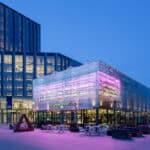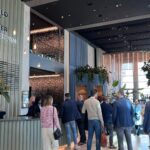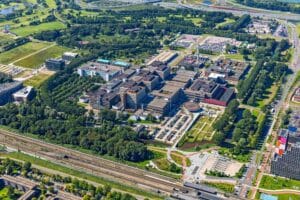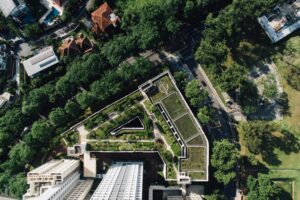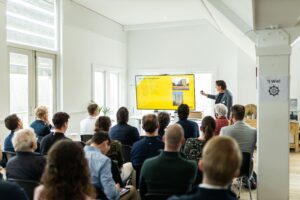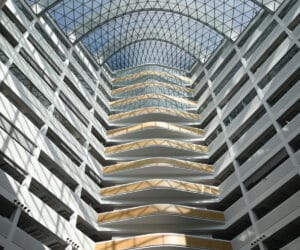

Innovation Dragons’ Den: innovations bring climate goals closer faster
They have been in force since 2020: the commitments of the Paris Agreement on climate change. The clock is ticking and the climate targets are coming closer. And our little country has not exactly been at the head of the European class when it comes to meeting them, so we, too, have our work cut out for us. Sustainable innovation and a serious energy transition in the built environment might be the key to beating the climate targets.
The fact that the construction and real estate sector is bursting with enthusiastic innovators became very clear at CFP Green Buildings’ tenth Innovation Day. This year’s theme was “Innovation Dragons’ Den”. Participants had five minutes to pitch their plans to save the planet and meet the climate targets.
Opening act: the Planet Escape Room
The tenth Innovation Day also had an opening act: the Planet Escape Room. The purpose of this escape room? Trying to save the earth by creatively solving puzzles. “It was a nice way to connect with other attendees,” says a participant. “But it really went by too fast!”
The Innovation Dragons’ Den
Bram Adema of CFP Green Buildings and Laetitia Nossek of the Dutch Green Building Council got straight to the point. “Innovators, you’ve got five minutes to give your pitch to save the planet.” Boas Kraaijeveld of CFP Green Buildings explained why it’s so important to invest now in innovations for the energy transition. “We are approaching the limits of our planet, for example depletion of the ozone layer, aerosols in the atmosphere, pollution of the ocean and loss of biodiversity.” According to him, not only does the construction and real estate sector have to change its ways, but we as a society also have to make changes. “We have to increase our positive footprint. We need to move away from grey, square houses and towards green walls and roofs; we need to make tiny forests out of parking spaces that are no longer needed. Basically, we need to bring nature back to buildings.”
Contributing to biodiversity
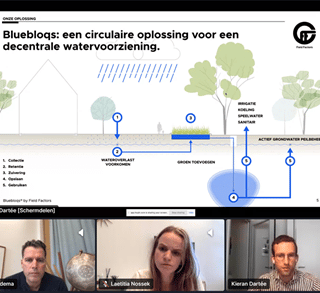
That is exactly what Daan Grasveld of The Urban Jungle Project is striving for: “We need to make things revolve around nature again. That contributes to a better urban climate, and increases property values.”
However, in the city that’s not as easy as it sounds: for one thing, space to plant trees is lacking. “Sometimes the urban layout won’t allow it, but it’s getting more and more important to do it because of extreme heat and increasing rainfall. That’s why we have come up with a solution to allow trees to contribute to biodiversity in extreme places. A tree can take root in the urban jungle, and we can track its nutritional needs with sensors so we can feed it the nutrients it needs. It’s a way to utilise the unused potential of existing buildings.”
Kieran Dartée of Field Factors highlighted the importance of climate-adaptive environments and emphasised how our climate is becoming increasingly extreme. “Summers are getting even hotter and rainfall is increasing, which will lead to more flooding.” In addition, the RIVM predicts a considerable increase in the demand for drinking water. “In 2040, we will probably be using 30% more drinking water than we are now.” Field Factors focuses on a solution that captures 95% of the rainwater that falls, to keep it from going to waste. “And it’s a compact solution, because in many urban environments space is at a premium. We retain rainwater and purify it to make it suitable for reuse.”
Sustainable Innovation for better living and increased productivity
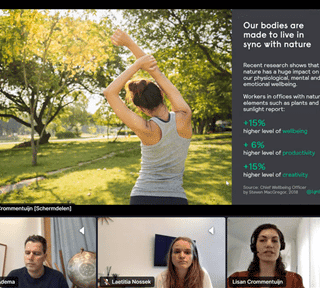
Lisan Crommentuijn and her company Signify is committed to advancing a healthy environment. She talked about Nature Connect. “Daylight is extremely important to us. We want to bring natural light back inside. In developing Nature Connect, we went back to nature and tried to connect the environment inside with that outside.”
“We provide different types of light and create natural colours on the walls. The combination of the three makes for the most natural experience possible.” According to her, this experience leads to greater well-being and productivity. “It supports a natural biorhythm, and makes people feel more energetic. And it makes your environment inspire you more.”
Walter de Groot of CircuWall talked to the participants about the opportunities that circular glue for sustainable buildings presents to help make circular building a reality. “After years of development, we have succeeded in developing a detachable and non-toxic adhesive.” According to De Groot, the adhesive is completely circular and can be removed without damaging the substrate. The adhesive layer is very thin – 35 to 50 microns – and is firmly attached. “At the same time, it is easily detachable and can be used in all kinds of floor finishes, such as carpet, poured concrete and marmoleum.”
From bio-waste to green energy
Rene Schers from Circ also focused on accelerating the pace of circularity. “There is a great opportunity to link food waste to upcycling, so that instead of simply throwing it away we start using it optimally.” With the Biodigester, Circ wants to provide an opportunity to convert local and small-scale bio-waste into green energy. “There’s a great opportunity in upcycling bio-waste in a way that is profitable for the local community, one that we are still missing out on far too often. You can get up to 80% of your energy from your own waste. A banana peel gives you enough energy to cook for half an hour.”
Steven Bleker of FIBERunlimited brought his efforts to bear on the energy transition and made a connection with the growing demand for digitalisation. “Mineral resources are becoming increasingly scarce. For example, our copper supply will run out in 100 years.” Copper is a raw material that is used on a large scale for things like network cables. “For every 100 metres of building you have 1.7 kilometres of traditional network cables that use copper. We should be doing this differently. Using Polymer Optical Fiber, we can provide an installation without connectors.” According to Bleker, that cuts the need for cables by 90%, so you can get the job done with only a small fraction of the copper.
Awareness and behavioural change
Behavioural change is not only an important requirement for achieving the climate targets. It’s also going to be a critical part of addressing the scarcity of raw materials. Immelie Fehmers from MBRC The Ocean, which is all about ocean cleanup projects, talked about this. “Over 11 million tonnes of plastic waste end up in the sea every year. We take fishing nets and plastic soup out of the sea, and use it to make things like recycled yarn.” When it sets up its local “cleaning hubs”, MBRC The Ocean is helping make the local population aware of the plastic problem. “That is how you stimulate behavioural change. The challenge now is to scale up the initiative.”
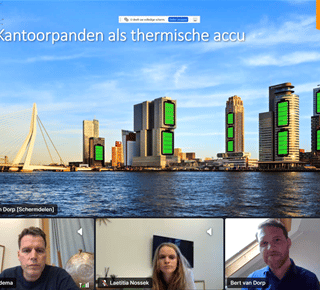
Next it was Orange Climate Group’s turn; Bert van Dorp described how the energy transition can be kept affordable with enough investment in energy innovation and new materials. “Phase Changing Materials ensure that the energy you store is not lost.”
“The times when you have energy in surplus, you store it, and the times when you have too little, you use it.” By putting these materials in things like ceilings, office buildings can become a thermal battery.
Water: the most important SDG?
Raymond Tieman of Smartvatten focused on one of the UN’s Sustainable Development Goals in particular. The SDGs address themes such as the environment and climate goals. Tieman focuses on water. “Start with that one, is my advice.” He explains why: “Agriculture uses 70% of all drinking water worldwide, and drinking water is the most important resource for human health. Water scarcity is a global problem that we need to address.” There’s lots of places in the built environment to address this, first and foremost by building knowledge. “Only 40% of all water use is transparent. We provide monitoring that can save you up to 20% of water. Then, the very first time you discover a leak, you’ve made your investment back right there.”
Broaden your knowledge and network at CFP Green Building Events
With the Dragons’ Den behind us, we are now looking ahead to the next CFP Green Buildings events scheduled for later this year, when we will be discussing climate objectives, energy innovation, the energy transition and more forms of sustainable innovation again. One of them is our Green Buildings Regatta, where more than 200 participants compete for a hotly contested trophy. All participants are people active in increasing sustainability in buildings and meeting climate targets. A great opportunity to network in a unique and informal way! On our website, we will keep you informed of all upcoming events concerning sustainability, climate objectives and energy innovation.
Written by Marvin van Kempen, Duurzaam Gebouwd


